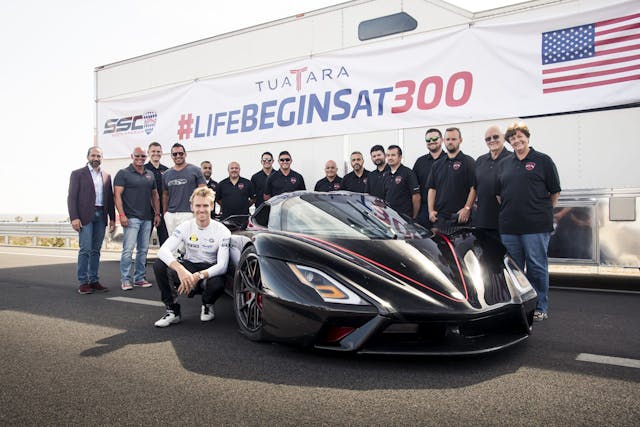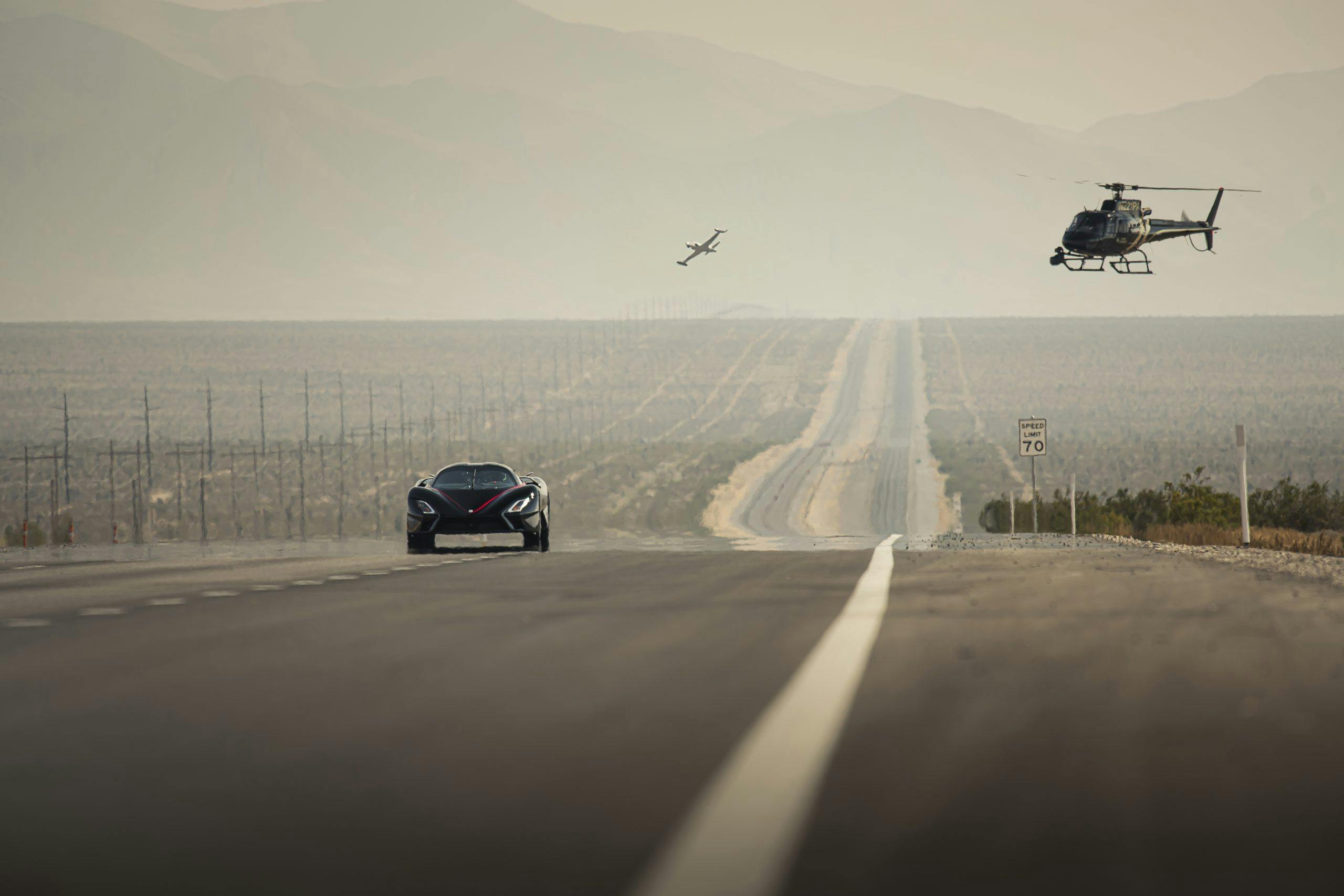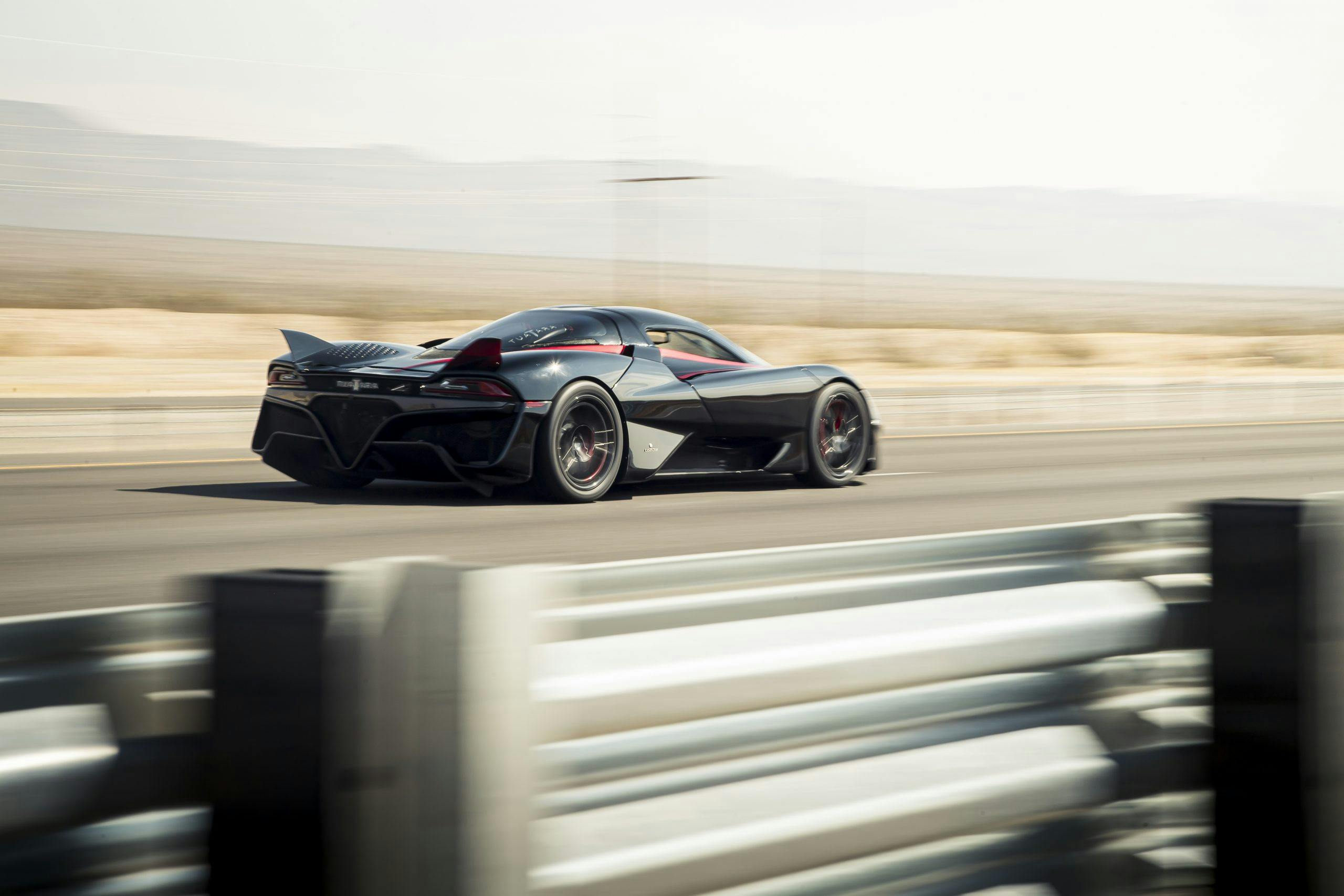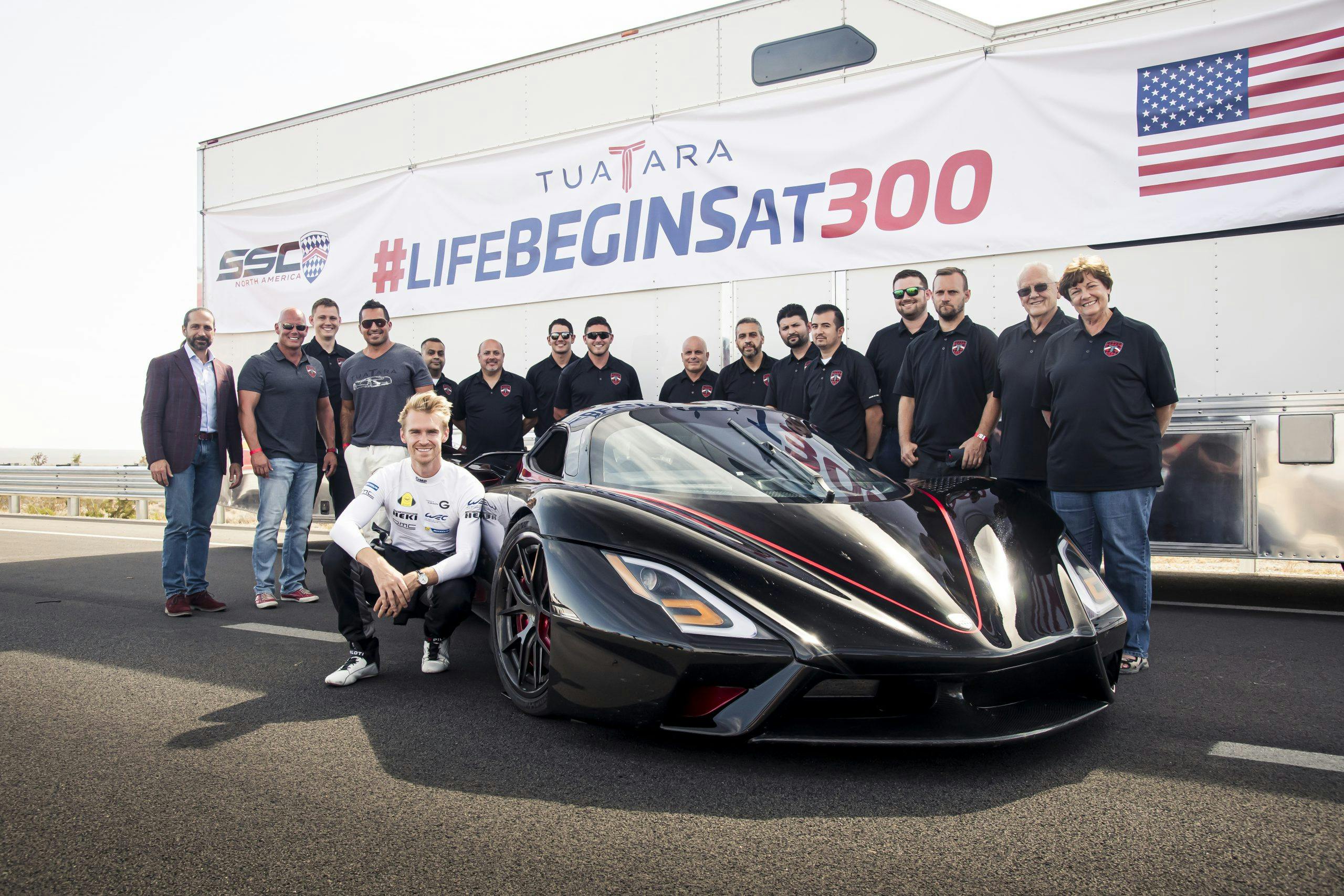Media | Articles
The wild story behind the SSC Tuatara’s record-breaking run
UPDATE 11/6/20: In response to widespread feedback, SSC has announced that it will rerun its record attempt with a renewed data recording plan. More details here.
For all the planning, simulations, and research that had gone into SSC North America’s assault on the production car top speed record, it seemed almost too cruel for a crosswind to be the fateful force that nearly derailed the whole thing. By now you’ve almost certainly heard the news: The SSC Tuatara hypercar shattered the record for the fastest production car in history earlier this month, hitting 331.15 on the final pass to average a mind-numbing 316.001 mph.
The history-making achievement is crazy on its own, but the story behind the record is perhaps even more outrageous. In an interview with Hagerty, SSC CEO Jerod Shelby detailed the circumstances that surrounded the attempt, as well as the emotional rollercoaster of the day’s events.
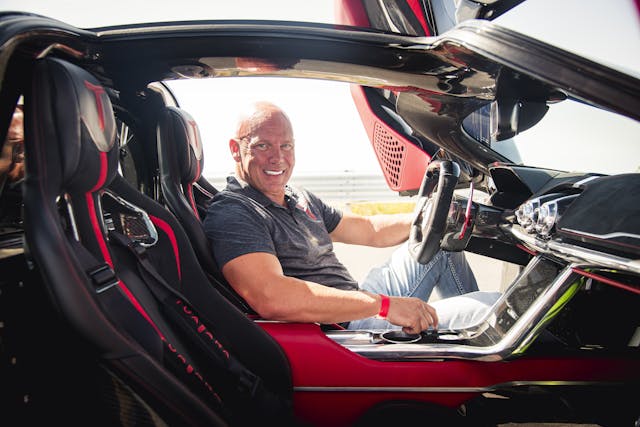
Getting up to speed
Unsurprisingly, 300-plus mph is far from a plug-and-play ordeal. There are endless variables to consider, not the least of which is getting the driver acquainted with the car. SSC flew in British racing driver Oliver Webb the Monday prior to the attempt on State Route 160 in the Nevada desert near Pahrump, so that he could get some seat time under his belt. Preparations began at an airport with a 5/8-mile runway at Calvada Meadows Airport in Pahrump, where Webb familiarized himself with the car’s behavior at high speed.
“Obviously, we wanted to show the capabilities of the car, but we wanted to make sure this test was done in a safe way,” Shelby explains. “This is a very dangerous test, even in a controlled environment.”
Marketplace
Buy and sell classics with confidence
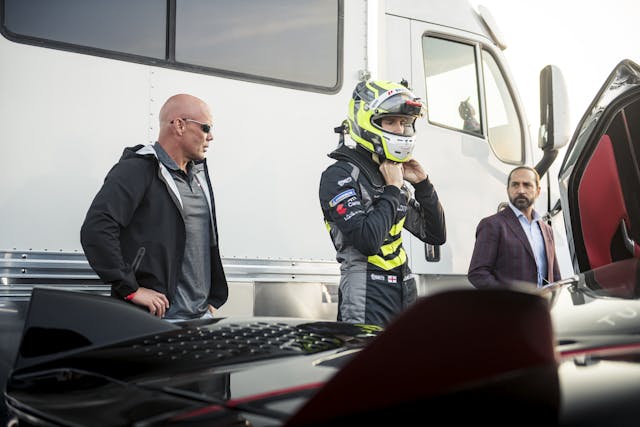
In just three passes, Webb was already hitting the limit for top speed while still being able to safely bring the car to a halt before the end of the runway. In Webb’s hands, the Tuatara had reached 206 mph from a dead stop. After a few more passes at those speeds, the team realized the need for a venue change. “It was just like, OK, we’re just putting wear and tear on the car,” Shelby says. Asking the car to sustain hard acceleration runs and heavy braking forces on a short runway wasn’t indicative of how the car would perform that Saturday on the closed-off stretch of Nevada highway.
After a bit of searching, the SSC team found a 7000-foot runway three hours from where it was stationed, at Nevada’s Tonopah Airport. Cars were packed, haulers prepped, and the caravan assembled to head out to this next venue. On the way, Webb caught a glimpse of a wild donkey on the roadside that had been struck by a car. Terrified, he asked Shelby, “Uhh, can those things cross the road while I’m going for this record?” Not hearing a firm “no” in response to that question was unnerving, to say the least. Wild donkeys aren’t something you want bothering you at 300 mph.
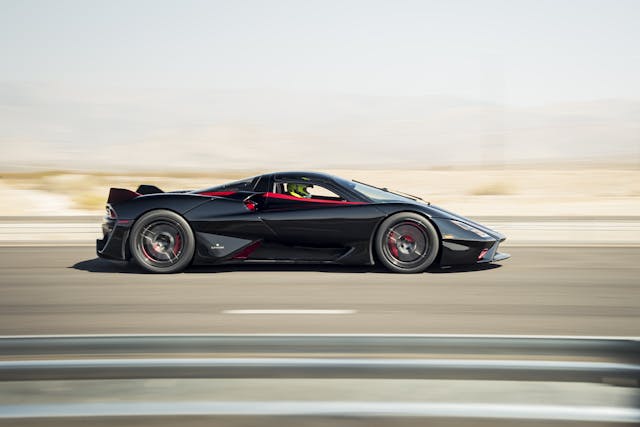
At the longer runway, Webb really began to stretch the Tuatara’s legs. “Our goal was to see if we can get it above 250 mph and get [Webb] a bit closer to what our ultimate goals are,” Shelby says. On the first pass, Webb clocked 248 mph. Then, he cleared 264. Then 270. Webb was not-so-jokingly saying they could maybe try for breaking the record that day, right then and there. After all, the Koenigsegg Regera RS‘s record run clocked in at just 7 mph faster. They weren’t that far off, despite having around 5.6 miles less pavement to utilize. SSC opted to stay the course and, with equal parts caution and confidence, the team turned its sights to the site of the main event.
History on highway 160
Details matter at these kinds of speeds, where a single error could spell tragedy, let alone failure. In preparation for Saturday’s big test, the SSC team snagged a rental car and headed out along the seven-mile stretch of State Route 160 that would be shut down. The goal was to mark every imperfection in the pavement; a small expansion joint might feel inconsequential at 80 or even 100 mph, but north of 250 those same cracks pose a more substantial threat. With the car in its lowest-height setting and serious downforce at play, the team’s full knowledge of the surface might be the difference-maker between a safe run and bottoming out at high speed.
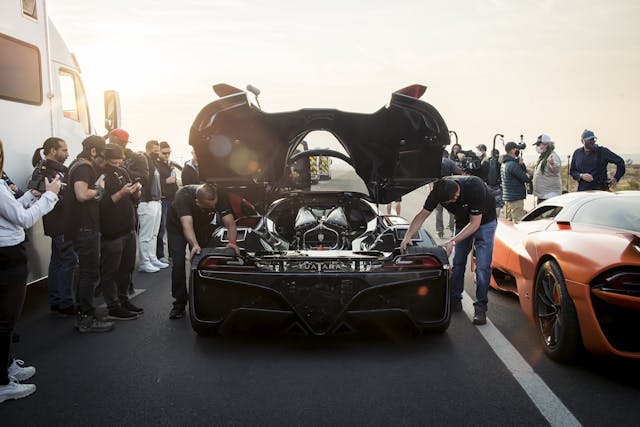
Webb, too, was preparing. Although he had an extremely positive outlook about the car’s high-speed poise on the long runway, he felt more restrained the when the day finally arrived. The pressure to deliver would be immense, and Webb was concerned about extraneous personnel around elevating collective expectations. “He didn’t want it where he got out of the car and had people saying, ‘Well, how much faster ya gonna go on the next run?’” Shelby explains.
Showtime
SSC’s ultimate goal was 500 kilometers per hour, or 312 mph. According to Shelby, 500 kph had been the magic number since the Tuatara’s inception way back in 2010. But no matter how much simulated testing the team had done, the real world brings its own challenges.
The day began well before sunrise, nerves tighter than Fender strings. The plan was to click off Webb’s runs as early as possible in the day, before the sun had a chance to climb into the sky and superheat the pavement. Elevated surface temperatures would pose a larger threat to tires that were already in for a long day.
As the sun inched over the horizon, Webb situated himself into the cockpit of the black Tuatara for a warm-up run. That initial pass also served to spot and experience the pavement imperfections that his team highlighted earlier that week. With components up to temp and satellite tracking equipment plugged in, the time had come.
Webb’s first at-speed pass returned an eye-watering 287 mph. The run was a great starting point for beating the record, which mandated two consecutive passes in opposite directions, conducted less than an hour apart. All he’d have to do was run the same speed the other way to secure the record. Before that, however, Webb hopped out of the car to call his father.
Not everything was coming up Milhouse, though. While perhaps not as horrific as wild donkey traffic, crosswinds were becoming an increasing source of concern. “All week we had no winds,” Shelby says. “The day of, they had called for some winds, and we had decided that if we had anything over 10 mph of [cross] winds, it was off.”
Painfully aware that one of the few factors his team couldn’t control threatened to call the whole thing, Shelby urged Webb not to waste time. They let the car cool for 20 minutes before Webb pointed the Tuatara the opposite direction and set off.
“He ran the opposite direction, and when he got back, he said that the wind was getting higher,” Shelby says. On that second run, Webb fought off a crosswind that pushed the car over one lane in the midst of its brutal acceleration. On the runway a crosswind is at least manageable, given that there’s typically more than 50 feet of tarmac to either side of center. An unexpected gust of even 5 mph on a two-lane public highway can be enough to precipitate a terrifying result.
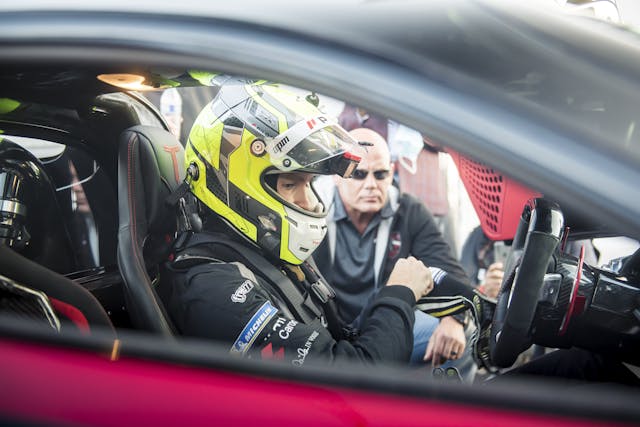
Webb remained optimistic. As he described how the car felt and recalled his harrowing cross-wind moment, engineers extracted the satellite data: 301.003 mph. Webb had broken the three-bill mark, to great applause from his team. The two runs brought the car’s average speed to roughly 293 mph, guaranteeing a new record.
Still, the Tuatara had more to give. That average speed was still well below the 312-mph magic target. Worse yet was the prospect of needing to use the 301 mph run as the lesser of two average passes. “With 301 [as the first pass], it doesn’t take a rocket scientist to know that you’d have to work a miracle now to get an average over 312,” Shelby says.
Then, Webb dropped a bomb. He announced that the next pass would be his last. At these speeds, he explained, getting hit with a blast of crosswind like he had experienced was deeply unsettling. He was going to become a father in two months, and the notion of something going wrong had shaken him. “My stomach kind of sank when he said one more run,” Shelby recalls. Of course, he understood the gravity of the situation and respected Webb’s wishes. “Biggest thing for me was that I wanted to make sure he was safe.”
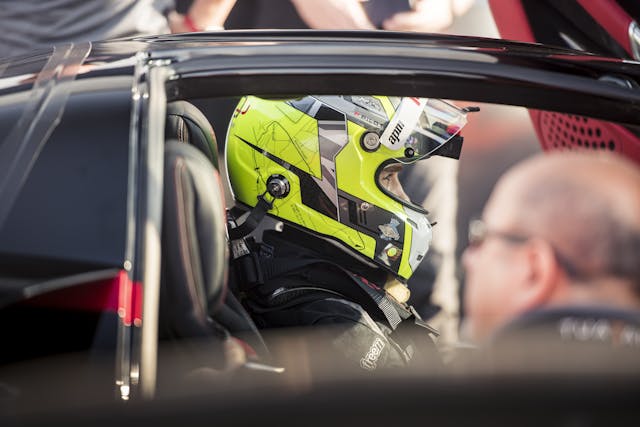
The Big Number
Webb slipped down into the Tuatara’s cockpit for one final pass. When Koenigsegg set its record on the same stretch of road two years prior, one direction proved quicker than the other. As fate would have it, Webb was pointing the Tuatara’s nose towards the faster of those two directions as he set off. Shelby and his engineer hopped in the rental car and headed in the same direction as Webb thundered toward the horizon.
Reaching the end of the road, Shelby saw the car stationary and intact, with Webb sitting on the pavement. His head was in his hands. At speed, a crosswind had nearly pushed him off the road just as the car was approaching top speed. Exasperated, Webb made it clear right then: That was it, he was done. Shelby was ready to relinquish hope of hitting the team’s target when the driver looked up and said, “I saw a big number, Jerod …”
The data trace confirmed a top speed of 331.15 mph, more than enough to clear the bar for a two-run average of 312 mph. Although it has yet to be verified by Guinness, the record appears sealed, along with three others: fastest flying mile on a public road, fastest flying kilometer on a public road, and highest speed achieved on a public road. The video below details the in-car footage from the final run. Although there’s no massive “moment” where the car suddenly jolts off course, note the position of the center white lines on the windshield in the helmet cam footage in the upper right. The car moves substantially to the right as Webb nears 331.
What now?
It seems unlikely that these records will be at risk in the near future. Then again, that’s been said about many such records before it, including Koenigsegg’s. SSC sees this achievement as just the beginning for the Tuatara. Not long from now, expect to hear whisperings of the hypercar blitzing Germany’s Green Hell. Will it crack that lap record as well? (Currently, the fastest trip around the Nürburgring is a 6:44.97 lap set by a Lamborghini Aventador SVJ, but we’ve heard that an AMG GT Black Series may have just eclipsed that mark.) We’re not placing bets on it, but it’s hard to imagine a more dramatic day than the one SSC just managed in Nevada. All before breakfast, too.
For more on the harrowing story of the record from the perspective of Jason Castriota, the Tuatara’s designer, be sure to check out this episode of our Daily Driver video series.
UPDATE 10/22/20: A Guinness spokesperson reached out to clarify that officials from Guinness were not present on site at the time of the record attempt. Currently, this is an unverified record, although SSC stated that all rules and proper procedures were followed. SSC has submitted the data from the runs to Guinness for official verification.
